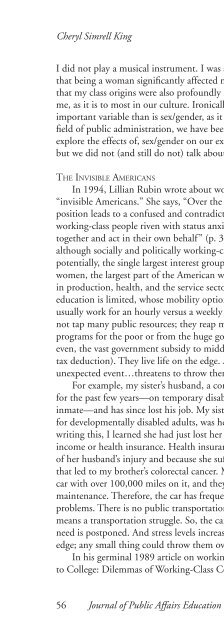WINTER 2012 - National Association of Schools of Public Affairs and ...
WINTER 2012 - National Association of Schools of Public Affairs and ...
WINTER 2012 - National Association of Schools of Public Affairs and ...
You also want an ePaper? Increase the reach of your titles
YUMPU automatically turns print PDFs into web optimized ePapers that Google loves.
Amy E. Smith <strong>and</strong> Ignacio J. Martinez-Moyano<br />
Phase I: Identification <strong>of</strong> Common Challenges<br />
Based on literature (Schacht & Aspelmeier, 2005; Yilmaz, 1996) <strong>and</strong><br />
interviews with three university faculty members who teach statistics in two<br />
master’s-level social science disciplines, we identified four general areas <strong>of</strong><br />
challenge faced by statistics instructors.<br />
1. Designing <strong>and</strong> selecting tools effective for learning is difficult.<br />
2. Students tend to have a low level <strong>of</strong> <strong>and</strong>/or limited background in<br />
quantitative skills.<br />
3. Students tend to want to memorize statistics rather than underst<strong>and</strong><br />
its underlying concepts.<br />
4. Students tend to have low levels <strong>of</strong> motivation, participation, <strong>and</strong><br />
engagement with the subject matter <strong>of</strong> statistics.<br />
After defining these challenges, we formulated one survey question per<br />
challenge to help identify the tools <strong>and</strong> techniques used to address each<br />
challenge. 3 For example, the question used to elicit ideas for addressing challenge<br />
3 was, “If you were <strong>of</strong>fering advice on the best way to teach statistics to students<br />
in practitioner-oriented master’s degree programs, what activities would you<br />
say are essential for addressing students’ tendency to want to memorize instead<br />
<strong>of</strong> underst<strong>and</strong>?” Participants were asked a total <strong>of</strong> four questions, one question<br />
to address each <strong>of</strong> the challenges identified above. The four questions asked to<br />
participants are included in Appendix A.<br />
Phase II: Sample Selection<br />
Using a purposive sampling method (Bernard, 2000), we identified several<br />
group characteristics for our participants. First, we wanted the participants<br />
to be experienced faculty members teaching in practitioner-oriented master’s<br />
degree programs. The idea here is, in thinking about teaching techniques that<br />
are effective, instructors need to have sufficient time (i.e., semesters taught) to<br />
develop teaching practices <strong>and</strong> experiences. In addition, teaching statistics in<br />
practitioner-oriented master’s degree programs where students are more likely<br />
to be consumers <strong>of</strong> statistics rather than producers presents unique challenges<br />
that may be different from the challenges in teaching statistics in other types <strong>of</strong><br />
master’s degree programs. For example, teaching statistics to master’s students<br />
in a public affairs program might be different than teaching statistics to master’s<br />
students enrolled in economics or computer science. Second, we wanted a<br />
participant group <strong>of</strong> approximately 20. Using an electronic Delphi technique to<br />
gather data requires a moderately small group for logistical purposes. A group<br />
with too many participants could generate a list <strong>of</strong> initial ideas that would<br />
be unmanageably large for the group to review <strong>and</strong> revise. Third, we wanted<br />
participants who were interested in discussing teaching techniques. We cast a<br />
wide net for participants, knowing that those who agreed to participate were<br />
116 Journal <strong>of</strong> <strong>Public</strong> <strong>Affairs</strong> Education

















